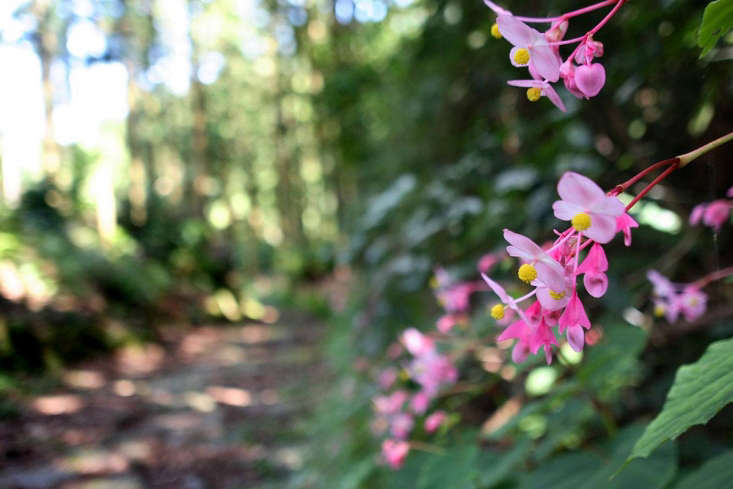Hardy Begonia, Begonia grandis: “Sun Shunner”
A hardy begonia that could survive northeast winters is something I never dreamed existed until a few years ago when, wanting a crash course in gardening techniques, I offered myself to the Brooklyn Botanic Garden as a three-day-a-week volunteer. I weeded, pruned, raked, and hauled mountains of trash out of the famous Cranford Rose Garden, the classic Osborne garden, and many other well-known areas. It was all exciting, but perhaps the most memorable experience was in a largely unknown border of shade plants that lies along grubby Washington Avenue, technically not even inside the BBG that most visitors enjoy. There I found the hardy begonia:

At the time the curator of the Washington Avenue horticulture outpost was Jennifer Williams, a tall redhead with infinite patience and a genius for finding and nurturing gorgeous, obscure sun-shunning plants. The hardy begonia was in Jennifer’s garden, thriving amid the Mahonia x media “Underway,” the Nandina “Plum Passion” and the Helleborus niger “Praecox.”

With its graceful panicles of bright pink flowers and pointy angel wing leaves that are bright green on top with veiny fuchsia undersides, the 2-foot-high “Heron’s Pirouette” cultivar contrasted artfully with its darker-hued neighbors. Because Jennifer was generous and understood that her unpaid workforce was crazy for plants, I was able to secure some Begonia grandis for my own garden. Her policy was that if any plants migrated to the dirt path, the volunteer who removed them could take them home. As a most enthusiastic clearer of pathways, I soon had several patches of these plants thriving in the shady areas of my backyard.

Cheat Sheet
- Deadhead the cascading white or bright pink flowers to keep your plants in bloom from mid July to fall.
- In the right spot, hardy begonia will naturalize. It will also self-propagate by means of tiny bulb-lets which form in the leaf axils in autumn.
- As temperatures cool in the fall, hardy begonia will deteriorate and literally fall apart, but resist the impulse to remove it to avoid displacing the bulb-lets which, if left undisturbed, will likely land on the ground and sprout the next spring.
- Begonia grandis combines well with classic woodland plants such as hostas, ferns, and hellebores. It also complements Daphne odora, Japanese forest grass (Hakonechloa macra ‘Aureola’), and Paperback maple (Acer griseum) as well as natives such as Solomon’s seal (Polygonatum) and sweet woodruff (Galium odoratum).

Keep It Alive
- Plant in part or full shade in rich, moist soil that should not be allowed to dry out.
- Begonia grandis will appreciate the addition of compost in the spring but does not need added fertilizer.
- Hardy in zones 6 to 9 but should be mulched during the winter in colder areas. With a heavy mulch, it can even sometimes be stretched to zone 5.
- Plant in a sheltered spot as begonias are fragile and easily damaged by wind or trampling by people or pets.
The ending of the story about how I acquired the hardy begonias in my garden is a little sad, but provides an important lesson in how to care for these plants. Since Begonia grandis appears later in the spring than many other plants, it is important to remember where you planted it and avoid disturbing that spot before the plants appear. I did not do that.
Last spring I heedlessly raked up the dead leaves and other fall and winter detritus from my garden without thinking once about the begonias. Weeks later I noticed they had not reappeared and was forced to face the awful truth that they had been unthinkingly removed and carted off to the compost pile. I hope I have learned my lesson. I will most certainly replace the lost begonias, perhaps with one of the newer cultivars such as daintier ‘Pink Teardrops’, the shorter ‘Smooch’, or the darker colored ‘Willowood Purity’.
For more growing tips, see Begonias 101 in our curated Garden Design 101 guides. See more of our favorite shade-loving perennials:
- Container Gardening: 12 Shade-Loving Plants in My Backyard
- Beth Chatto’s Garden: Shade-Loving Plants for Year-round Interest
- Design Sleuth: The Ultimate Shade Garden









Have a Question or Comment About This Post?
Join the conversation